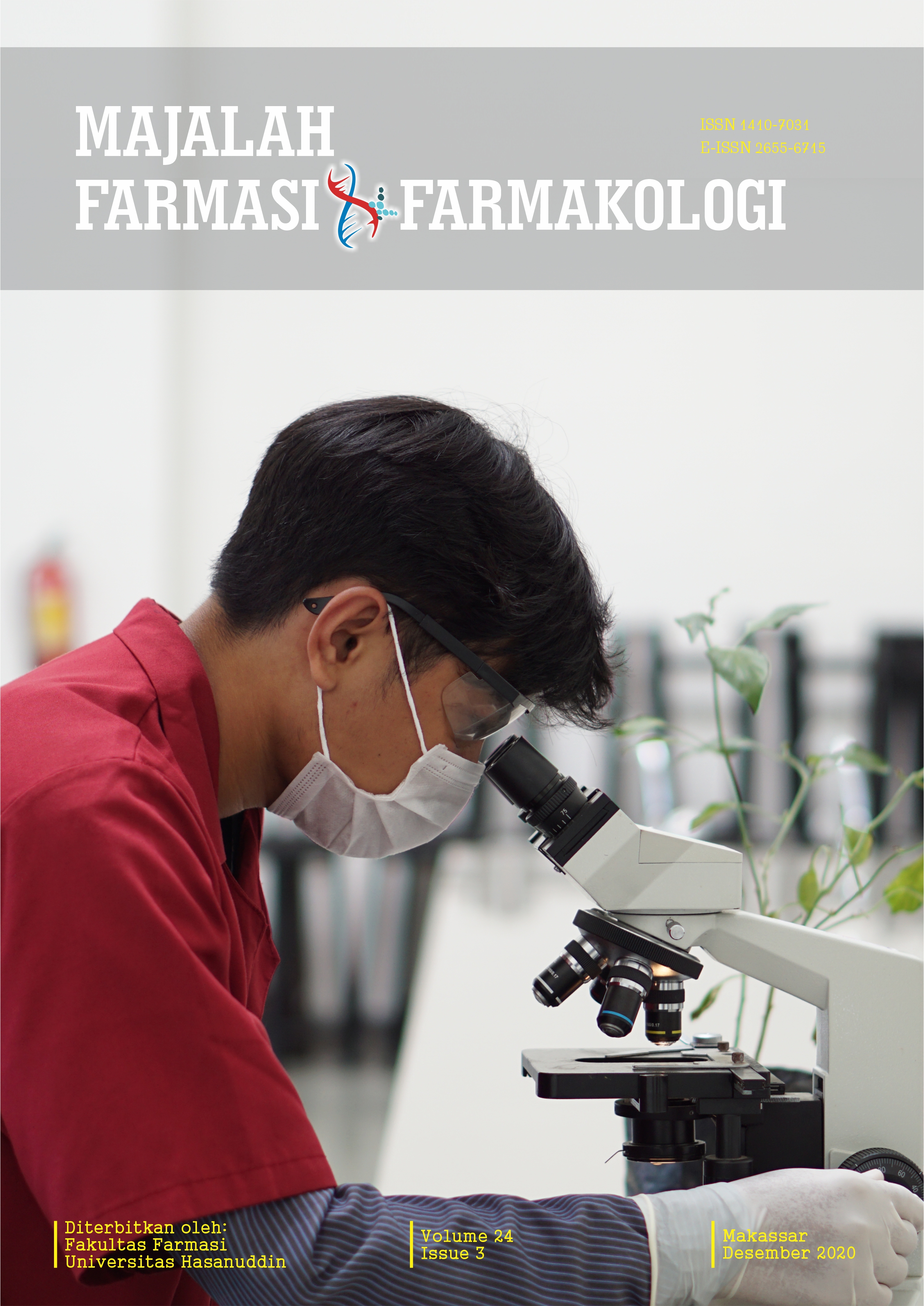EVALUASI PENGGUNAAN ANTIBIOTIK DEFINITIF PADA SEPSIS NEONATORUM AWITAN DINI DAN LAMBAT DI RSPAD GATOT SOEBROTO
Keywords:
sepsis neonatorum, baterai, antibiotik definitifAbstract
Angka kejadian sepsis neonatorum yang tinggi karena sulitnya penegakan diagnosis disebabkan faktor klinis tidak spesifik. Pasien akan mendapatkan antibiotik setelah 1 jam yang diduga sepsis. Hal ini meningkatkan resistensi karena penggunaan antibiotik tidak rasional. Maka perlu ibu serta pasien sepsis dan penggunaan antibiotik. Penelitian deskriptif analitik dengan studi kohort retrospektif menggunakan data rekam medis yang memenuhi kriteria inklusi. Analisis data secara bivariat dengan uji chi square pada p≤0.05. Ada 98 pasien (SNAD 55 pasien; SNAL 43 pasien). Hubungan hubungan antara ibu hamil kehamilan kehamilan SNAD (p = 0,025), kehamilan kehamilan kehamilan (p = 0,020).Hubungan antara hubungan antara variabel pasien detak jantung terhadap SNAD (p = 0.010). Evaluasi metode DDD didapatkan antibiotik yang sering digunakan yaitu meropenem 20.147 DDD / 100 hari sabar . Analisis hubungan antara metode Kunin terhadap luaran klinis pasien SNAD (p = 0.175; RR = 2.316; 95% Cl = 0.677-7.919), lama rawat (p = 0.057; RR = 4.929; 95% Cl = 0.954-25.469). Analisis hubungan antara metode Kunin terhadap luaran klinis pasien SNAL (p = 0.811; RR = 1.167; 95% Cl = 0.331-4.116), lama rawat (p = 0.110; RR = 0.525; 95% Cl = 0.391-1.705). Hasil tersebut menunjukkan bahwa tidak ada hubungan antara kerasionalan penggunaan antibiotik definitif dengan luaran kinis serta lama rawat yang di nilai menggunakan metode Kunin.
Kata kunci: sepsis neonatorum, baterai, antibiotik definitif
References
Hadinegoro SRS, Chairulfatah A, Latief A, Pudjiadi AH, Malisie RF, Alam A.
Konsensus diagnosis dan tata laksana sepsis pada anak. Badan Penerbit
IDAI. Indonesia; 2016. 1-47 p.
Departemen Kesehatan Republik Indonesia. Penatalaksanaan sepsis
neonatorum. Departemen Kesehatan Republik Indonesia. Jakarta; 2007. 1-
p.
Pusponegoro TS. Sepsis pada neonatus (sepsis neonatal). Sari Pediatr.
;2(2):96–102.
World Health Organization. Perinatal mortality a listing of available
information. Geneva; 1996. 1-152 p.
Darmstadt GL, Bhutta ZA, Cousens S, Adam T, Walker N, Bernis L de.
Evidence-based, cost-effective interventions: how many newborn babies
can we save? Lancet Neonatal Surviv Steer Team. 2005;365(9463):19–30.
Juniatiningsih A, Aminullah A, Firmansyah A. Profil mikroorganisme
penyebab sepsis neonatorum di Departemen Ilmu Kesehatan Anak Rumah
Sakit Cipto Mangunkusumo Jakarta. Sari Pediatr. 2008;10(1):60.
Putra PJ. Insiden dan faktor-faktor yang berhubungan dengan sepsis
neonatus di RSUP Sanglah Denpasar. Sari Pediatr. 2012;14(3):205.
Ellisa P. Faktor-faktor yang berhubungan dengan Kejadian sepsis pada
neonatus di Rumah Sakit Agung Jakarta Tahun 2017. Univ Esa Unggul.
;1–7.
Wagstaff JS, Durrant RJ, Newman MG, Eason R, Ward RM, Sherwin CMT, et
al. Antibiotic treatment of suspected and confirmed neonatal sepsis within
days of birth: a retrospective analysis. Front Pharmacol. 2019;10(Article
:1–10.
Rohsiswatmo R. Multidrug resistance in the neonatal unit and its
therapeutic implications. Paediatr Indones. 2006;46(1):25–31.
Menteri Kesehatan Republik Indonesia. Program pengendalian resistensi
antimikroba di rumah sakit. Jakarta; 2015. 1-32 p.
Kunin CM, Tupasi TE, Craig WA. Use of antibiotics. A brief exposition of the
problem and some tentative solutions. Ann Intern Med. 1973;79(4):555–
Chan GJ, Lee ACC, Baqui AH, Tan J, Black RE. Prevalence of early-onset
neonatal infection among newborns of mothers with bacterial infection or
colonization: a systematic review and meta-analysis. BMC Infect Dis.
;15(118):1–16.
Simbolon D. Faktor risiko sepsis pada bayi baru lahir di RSUD Curup
Kabupaten Rejang Lebong. Bull Heal Res. 2008;36(3 Sep):127–34.
Leifina N, Yuniati T, Kartasasmita CB. Kadar laktat darah sebagai faktor
risiko mortalitas pada sepsis neonatorum. Maj Kedokt Bandung.
;45(4):199–205.

Downloads
Published
Issue
Section
License
Copyright (c) 2020 Majalah Farmasi dan Farmakologi

This work is licensed under a Creative Commons Attribution-NonCommercial 4.0 International License.
The copyright to this article is transferred to Universitas Hasanuddin (UNHAS) if and when the article is accepted for publication. The undersigned hereby transfers all rights in and to the paper including without limitation all copyrights to UNHAS. The undersigned hereby represents and warrants that the paper is original and that he/she is the author of the paper, except for material that is clearly identified as to its original source, with permission notices from the copyright owners where required. The undersigned represents that he/she has the power and authority to make and execute this assignment.
We declare that:
- This paper has not been published in the same form elsewhere.
- It will not be submitted anywhere else for publication prior to acceptance/rejection by this Journal.
- A copyright permission is obtained for materials published elsewhere and which require this permission for reproduction.
Furthermore, I/We hereby transfer the unlimited rights of publication of the above-mentioned paper in whole to UNHAS The copyright transfer covers the exclusive right to reproduce and distribute the article, including reprints, translations, photographic reproductions, microform, electronic form (offline, online) or any other reproductions of similar nature.
The corresponding author signs for and accepts responsibility for releasing this material on behalf of any and all co-authors. This agreement is to be signed by at least one of the authors who have obtained the assent of the co-author(s) where applicable. After submission of this agreement signed by the corresponding author, changes of authorship or in the order of the authors listed will not be accepted.

